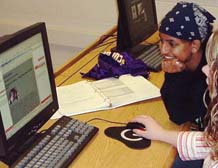Using Case It! materials in classes 
Note: More detail on class use is provided in the Supplementary Materials from an essay in Science 27 Jul 2012: Vol. 337, Issue 6093, pp. 426-427
General suggestions for class use
Most of the cases currently available were developed for use in introductory undergraduate biology classes to help students address concepts and issues in molecular biology, but they can be adapted to a variety of educational settings. These cases guide students through the analysis steps and then provide focused questions to prompt interpretation and application of the results.
Each case description includes the case scenario and instructions for analyzing the case, as well as background information and discussion questions. Students first read the background information provided and gather additional information from online sources (e.g. http://www.cdc.gov/). They then carry out the analysis, interpret results, and discuss the significance of scientific and social issues raised by the case. Alternatively, instructors can edit the cases to add or omit information as appropriate for the backgrounds of students and the course objectives. Students may be asked to:
- Focus on the ethical and social issues raised by the analysis and the decision-making process involved
- Take on a particular role, e.g. genetic counselor or family member, and present the case interpretation from that perspective (see below for more details).
- Develop hypotheses about the results, based on background information about the molecular biology in the case, before running the analysis
- Start with the case analysis and results, then carry out their own research to obtain information necessary to interpret the case
In addition to using cases and sequences provided with the simulation, instructors may develop their own cases using DNA sequences obtained from GenBank or elsewhere. Sequences, restriction enzyme sites, probes, primers and antibodies are all read by the simulation as editable text files. Students in more advanced biology courses can be assigned to develop new cases. These student-designed cases can then can be subjected to peer review, and used by students in introductory courses.
Since the Case It simulation works with any DNA or protein sequences, students can use the software for open-ended research projects, accessing online sequence databases or research articles to gather sequences they need to address their research questions.
Presentation of case results
Students can present their case analyses in a variety of formats, including
- Conventional lab reports, where students insert images from the simulation, write an interpretation, answer the questions, and/or extend the analysis with additional research
- Presentation to the class, as individuals or groups, displaying the images from the software while providing interpretations and background information
- Posters with images and text, which can be printed and used in a poster session where students interact in person to ask questions about the cases
- Online poster sessions or other online presentations
Role-playing and online communication
With the human genetic disease, cancer, and infectious disease cases, we have had particular success when students interact online, taking on different roles as they analyze and discuss the case results. Students work in teams using the Case It simulation to analyze samples in the case, then present their results in web-based format. Any online system that allows students to upload images and text and communicate interactively could be used to accomplish these steps. (Alternatively, this could be accomplished in a lecture setting by projecting images and asking students to play roles as they discuss case results.) For example:
- Play the role of a lab technician, using the Case It simulation to analyze DNA or protein samples. Images from the simulation are saved and posted to a web page, along with background information and an interpretation of the results.
- Play the role of a genetics or health counselor, then compose a statement to the patient or family, prior to discussion in a lab or lecture setting.
While interacting online, students switch between roles when they ask and answer questions. For example, when students visit other web pages they play the role of patients/family members in the case, whereas when responding to questions about their own web pages they play the role of genetic/health counselors. It is possible to do something similar in person rather than online, but in our experience students prefer the anonymity of online communications because they can be more open in their answers and it is easier to assume roles. An online format also gives them more time to reflect and gather information before responding.
Examples
Genetic disease case with online role playing
HIV case with introduction to bioinformatics
Research applications
Case It v7.0.4 has enhanced features for student research applications, including the ability to search sequences for probe/primer sites, and general searching of DNA and protein sequences, at any stringency (match %) setting. An example involving color vision in primates and other animals is described as a research project, with detailed instructions in a tutorial on sequence analysis. Another good introduction to research methodology is the CRISPR exercise, which also includes detailed instructions on software use.